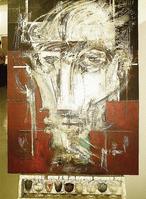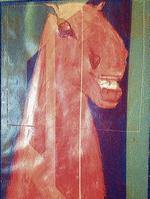Anthea McGibbon, Gleaner Writer

'Melancholia Imaginativa for Sviatosla' by Dr. David Boxer (left) andOmara Ra's 'Red Horse' (right). - Photos by Anthea McGibbon
Art buffs, Paul Chen Young and Wallace Campbell were among some 200 patrons entranced by an exhibition organised by Dr. David Boxer and other Jamaican artists last weekend at the Pan American Art Gallery in the United States.
Largely dominated by works of Dr. David Boxer and Milton George, the exhibition featured works by self-described intuitive photographer Paul Stoppi, Omara Ra and Stanford Watson. Overall, the works had the common feature of bold commentaries of personal island experiences by the artistsfrom an autobiographical perspective.
The rooms, at the opening, were underlit, and sufficient documentation for guests who packed the room was lacking, but the exhibition compensated in its value.
In the opinion of Miami fine artist, Annelliese Pop, the exhibition was enjoyable, providing for her a sense of happiness. Her preference were the sensitive works of Dr. David Boxer.
"You have to reconstruct the broken pieces in your mind as they are evocative in a sensitive way," she told The Sunday Gleaner.
Architect Ilija Mosscrop, who has done work extensively for Christopher Blackwell on the island, was one of the patrons expressing appreciation that such Jamaican art exhibitions are being displayed in Miami, and had an appetite for more. For him, the present show "is visceral and thought- provoking".
Not a fan of literalism, Mosscrop was captivated by Omara Ra's Red Horse 1, II, & III for its message and Fragmented Diasporal Thought I & II for their earthly, "so tactile" nature.
Articulating I and I by Stanford Watson was considered powerful and evoking, as "the grid-like structure combines with organic and enhances in appeal," he said.
Miami resident Paul Stoppi's collages of layered photographs are crisp and meticulous, and are his bridges to cross over from Jamaica to Miami. Through strategic placement of evocative images - dogs in heat, cocks, and a laughing donkey - he evokes humour, hence rescuing frames from being otherwise empty compositions.
Photography and art
Denise is blaring, but dispels tensions between photography and art. The captured partially nude model, Denise, sitting in a large washtub, is layered over the photographed McArthur Causeway. Stoppi means to join Miami to South Beach, adding a Jamaican accent - Denise, a full-bodied Jamaican woman who is laughing her head off, is happy to have crossed over to the land of opportunity.
His For Thine is The Kingdom, brings heaven to earth as we are reminded by the happy, mentally-retarded boywearing a king's crown that the meek shall inherit the earth.
The invading snap of two dogs having sex in the black and white Plato Loves Trixie, owned by the National Gallery, is repeated in a circle of happiness. The Mighty fighting cocks of Providence is Stoppi's largely red memoir on Jamaican cockfights that he was forbidden to go as a child.
Milton George's pieces are purposefully placed beside Stoppi as his energetic expressions complement the equally unconventional mind.
Large, beautiful, and very expressive the earlier works are George's fight against violence and corruption in Jamaica. The Heap of painted wasted cans, symbolise junk and corruption while, in Large Head, he provokes thought on the responsibilities and repercussions of Jamaicans and their behaviours.
The strongest piece by artist Stanford Watson is Articulating I & I. Watson's mixed media works are all about violence. There are X-ray sheets, newspaper clippings juxtaposed and superimposed in Articulating I & I - 70x115 inches of black fabric tiles of paint. Muffled text descriptions of hideous events and scenes in Jamaica, in a mysterious role torments the overall composition.
Watson, in his pieces, deals with the diaspora especially in Fragmented Diaspora Thought 1 & II (74.50x41.50), commenting on migration to the United States. The crocus bag against the painted dirt texture with dirt surface provokes memories of destitute Jamaicans.
Large Head is the dominant piece of Omara Ra's exhibits. Ra, a strong advocate of Jamaican victims discusses prejudice and the hints of colonialism as observed in Jamaica today. He criticises the white elites 'above' the darker-skinned Jamaicans and the ironic resulting usurping of authoritative power by darker-skinned persons over lighter-skinned Jamaicans, which makes these earlier works still relevant today.
Ra was simply not comfortable and described the injustices through his painted autobiographies.The binding and soothing factor of the exhibition is the confident and witty works of Boxer placed in the main rooms of the Miami space. Settling in his contemporary works, he sublimes through his self-portraits, which are mostly influenced and/or taken from installations, although laced with experienced and observed inner pains. Queen Victoria set we free (1996-2003) is influenced by the Chorus of Souls installation, while from 'The Caggiano' installation, Melancholia Imaginativa for Sviatoslav is created.
A combination of Beethoven, Rict, his own self-portrait, Boxer brings out the melancholic spirit in the dominant work. The actual wine glasses, which are Boxer's painting palette are sacramental and like the easel, are placed as a part of the presentation of Melancholia Imaginativa for Sviatoslav.
Self-Portrait is essentially cubism suggesting different states of mind and offers as much rhythm as other Boxer exhibits such as Havana Postscript and Black Passage unlike the pessimistic Melancholia Imaginativa for Sviatoslav.
Sensitive work
The Last Journey of Jean Michel Basquiat (1994-2002), is creatively intriguing, and perhaps the most sensitive of Boxer's works. This triptych is unique as it can further be viewed in two equally designed sections - a diptych and a single frame. In the first two panels - the diptych - Boxer depicts the snakes which friend Basquiat envisioned surrounding him. Boxer uses the third panel, however, to put the snakes in perspective as being in the mind of the artist. Titled for its account of the literal last journey of his friend who might have known he was about to die, Boxer relates how Basquiat committed to giving up his addiction to coke before going on that "last journey".
Interestingly enough, Boxer successfully relates the movement of slaves from Africa to the New World in Passage Black, with the spanse of illustrated black sea conveying movement. This is the fourth in a series following a blue, red, and white version. Thirteen years of working in gauze and thread resulted in Gauze Head/Self portrait reflecting Boxer's ideal that wounded person can be reconstructed.
As an artist, he reaches out to the pain of fellow Jamaicans on a personal and nationwide scale and through this piece muses on how he and other artists can offer reconstruction and healing. Boxer is indeed a sensitive artist who emphasises with others through his works. According to gallery curator, Irina Leyva-Prez, "He continues to study, select, purify, deconstruct and legitimise."
Above all, Saint Sebastian is used as patron saint of the Aids epidemic, and, accordingly, red arrows are being thrusted into the collaged image of a hurting man. Boxer's love for glass and transparencies comes out in his study of glass Still Life-Fugue, where the shapes are somewhat unique, but the colours are bold yet sensitive.
Overall, the contemporary exhibition is a vivid educational accounts of Jamaican experiences. Coverage was made possible by Air Jamaica (transportation) and Impact Limited, Florida.
Anthea McGibbon, a graduate of the Edna Manley College of the Visual and Performing Arts , has over 10 years experience in the field of journalism and the arts. Contact her at islandartattack@yahoo.co.uk or anthea.mcgibbon@gleanerjm.com.

